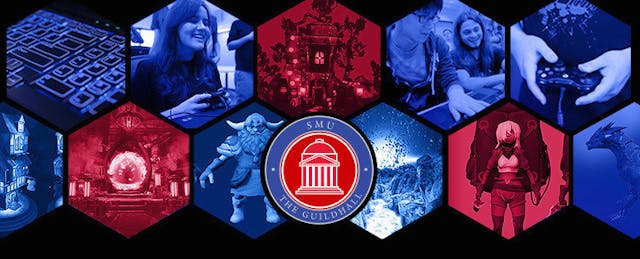It’s not easy being a game designer in college. Justin Couchot and Spencer Humphries, creators of “Brobot Beatdown,” refashioned their entire game—almost five months worth of work—in just four weeks before the College Gaming Competition at the Electronic Entertainment Expo (E3). They had beaten out 17 games from their school, the Savannah College of Art and Design (SCAD), for the chance to do so. They won.
Couchot and Humphries led the team that won the fourth College Gaming Competition for SCAD. The school’s teams also won in 2013 and 2014, and the contest has only been running for four years. To enter, students from video game development programs submit their games to a panel of industry veterans, who in turn evaluate the games.
What goes into making these games? We spoke to Couchot and Humphries about their championship, but we wanted to take a deeper peek into what it’s like to be a student (or a recent graduate). We talked to two game creators—one technical designer and one artist—about how their game came to be and what they’ve learned from it.
Taylor Pate, an artist from Southern Methodist University’s Guildhall program, said that improvising and hoping for the best played a large role in the creation of her team’s game, “Gravitas.” It’s been greenlit (approved) on the distribution platform Steam.
“All our concept art was for other games because we had come up with so many ideas before we actually started,” she said. “So we winged this one with three pieces of concept art. We had a fun gravity mechanic to start with, and we asked ourselves, ‘Where can we put this so it would make sense?’”
Gravitas game was also a finalist in E3’s College Gaming Competition. No one on the team had ever been to the convention before.
“We’re feeling both big and small next to the huge companies,” Pate said on the floor of the show. “Right now, though,the excitement is winning. We’re right next to the Square Enix booth, which is so unreal. Look at that!” Here she gestured to a demonstration of Final Fantasy XV. “This is probably the coolest thing I have ever done.”
The gravity power came to make sense in a mad artist’s gallery in low-earth orbit. Pate said it started as a joke, but it was a joke that wouldn’t go away. Eventually, despite its lightness, the gallery idea became the best fit for the gameplay that the team envisioned.
Players make their way through the gallery using the ability to manipulate gravity. They solve puzzles made by slightly off-kilter character of “the Curator.” A cute cube named SHI gives hints and helps the story progress as the player’s companion.
Creating videogames also entails working on a team. The gaming experience can be as solitary as the player likes, but game design is a group project.
For Alex Shilts, a technical designer from SMU’s Guildhall, that meant stomaching some unpleasant truths about himself. He applied for the position of game designer, the leader of the team, with a high degree of confidence, but Guildhall chose Tyler Morgan for the position instead.
“I focused on what I could bring to the team,” Shilts said. “I said that I’d do this and that and the other thing and so much more. They wanted to hear about collaboration, for me to be cognizant of the other members of the team. I learned that when I scheduled meetings to ask about what I could have done better.”
The process of submitting the game wasn’t any smoother. Shilts felt like he was flying blind getting to the contest. He didn’t feel like Guildhall gave him team enough support. Despite the fact that E3 is the biggest video game trade show in the country, he said Guildhall didn’t give the students any information on the College Gaming Competition.
Because of a dispute over rights between E3 and SMU, Gravitas’ submission process took much longer than is typical. Once the show had selected game as a finalist, SMU needed to ratify the contract, which meant that Pate arrived at the show not knowing if she and her team would be welcome.
“We were the last people to accept, so we never got confirmation emails, never got anything,” she said. “We just showed up and said, ‘Where do we get badges? What’s going on?’ Everyone was like ‘Who are you? What is this?’ But it’s worked out.”
Hear our full interviews with Taylor and Alex below.


